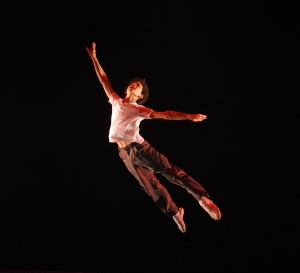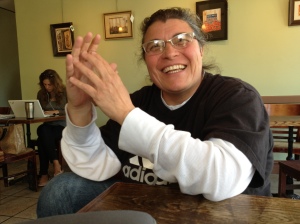The Muse Dialogue, Our Tale
by Andrew Swensen
My mornings begin with a little adventure of discovery. Like so many people, I settle down with a cup of coffee and my computer, and then read or listen to the offerings from National Public Radio, American Public Media and Public Radio International – especially The Writer’s Almanac, On Being, The Story, This American Life and Frank Deford. One day, an observation arose: Some time not too long ago, every one of these pieces was a radio story, but it has been years since I have listened to a radio in my home. A wealth of fascinating material arrives through this magical device on my lap, and each piece tells an interesting story with personality, conviction, and a healthy intellectual curiosity.
At this point an idea begins to coalesce.

Billy Elliott, as performed by David Alvarez. Billy knows the joy of art and is featured in our article “Boys, Dance and Gender Stereotypes in the Arts.” (Photo: http://www.billyelliottour.com/us-tour)
Increasingly we receive things through the world of “asynchronous” media. This is a fancy way of saying that in our era of online media, we read or listen to something whenever we want and typically find them from an email, Facebook post or a tweet — rather than hearing something broadcast to us according to a schedule determined by a media outlet. We should be doing more of this in the arts, I think, and as the adage goes, “I used to think that somebody should do something about this, and then I realized that I am somebody.”
There are certainly plenty of good sources on the arts, but what I had in mind was not “reporting” or arts reviews (ArtsJournal and Huffington Arts and Culture do good work already). The goal for this venture would be to uncover good narratives, to cultivate a spirit of essayistic writing, writing that has a personality and takes a road perhaps less traveled. I had three priorities, and they remain with me still.
The first is a sense of wonder and delight in the discoveries of serendipity, which is often how we learn about things that later become the most important to us. Serendipitous discovery is the hallmark of intellectual curiosity, both in an author and a listener/reader. Though we may listen to the same program or read the same column every week, we never know what it is going to bring us. If it is done well, authors share the discovery of authentic narratives. Here I think of This American Life, On Being, or one of my lifelong favorites from the world of old media, National Geographic. We learn so much that we never knew could be so interesting.

Amy Enrico, Owner of Tazza D’Oro, loves art and was featured in our article on arts and business.
Second, I love writing that takes risks. What I have in mind differs from what some might expect from those words. Plenty of people are willing to tear other people down and take easy shots with words that have shock value, in order to attract attention to themselves. Disliking things is often easier than liking things, and it seems that many equate disdain with being cool. However, too often people equate acerbic words with candor. Tearing others down is typically the antithesis of risk because it comes from a place of insecurity; it is the action of fear and not of courage. The arts need their Frank Defords and Ira Glasses, someone willing to take a narrative risk and tell a good tale in the process. Someone who is even willing to take the risk of liking something subjected to scorn. Moreover, while the internet teems with good writing on the arts, many of us are reluctant to say things, often for a variety of good reasons. We try to put on a good face because these are times of anxiety. People worry about funding and about alienating a foundation, they worry about attracting audiences, and they worry about getting a job. Yet I like stories that step into that space of anxiety and still speak candidly. I regularly tell contributors to step outside their comfort zones because in this space we express our true selves. In the arts, it is often a risk to reveal that authentic self, with all of its hopes and fears.
One final essential ingredient is a love of art itself. Much arts commentary strikes me as devoid of love, choosing instead the pose of jaded cynicism and even bitterness. We need less intellectual grandstanding and more joyous passion in the arts, less snarky diffidence and more celebration for the gift that art brings to the world and to us. Art has the ability to reach deep within us, into our individual psyches and souls, and into our collective unconscious. It is the place where we wrestle with love and death, where we search for meaning and confront anxiety over the uncertainties of human existence and experience. It is the beauty that enriches our lives, as well as the fantastic space of our shadow selves. It is the expression of our longing and our wonder. A healthy love for this magnificent endeavor leads to those moments of discovery and insight that we ought to share with one another.
With these thoughts in mind, I approached some colleagues. Dan Martin, the Dean of the College of Fine Arts at Carnegie Mellon University, wholeheartedly embraced the idea and offered to give the concept its first legs at CMU. The Muse Dialogue was born.

“Theater is a social art form.” From a Muse Dialogue article by Jeffrey Carpenter, a theater director and author willing to take risks as in his article “Occupy Theater.” (Photo Courtesy of Bricolage)
Goethe once wrote, “Personality is everything in art and poetry.” The same can be said regarding those writing about art. We learn from the personality of others as they share their ideas, their passions, and even their worries with us. One of our regular contributors, Alexandra Holness, characterized the distinctness of The Muse Dialogue as the “timelessness” of the articles and by the opportunity to “explore ideas that have been floating in our heads and exploring them.” I agree. In the process, we hope to live up to our name and generate dialogue as well.
These are interesting times in the arts. I teach an aesthetics course, where many of the story ideas have been born. Over the years my students have taught me a great deal about our world of art in transition – the innovation in emerging and rising arts, and about older art forms for which audiences are waning. Some art forms seem to suffer from unfortunate neglect, and two early ideas were to write about poetry and about chamber music. Both of them are wonderful, but as far as I can tell, people seem to have a barrier to them now, maybe even a stigma, as if these arts have become passé or too intellectually removed. Some other art forms are in genuine crisis, and yet people do not want to talk about it. I do.
We have also approached topics with a sense of aesthetic inquiry. Some topics concern human activity that presses the perimeter of what we call art, and among my favorite topics – neither my idea – were series on “Is Fashion Art?” and “Is Food Art?” Topics such as these awaken that special place of intellectual curiosity that I mentioned earlier, and I am grateful to our authors who have taken genuine delight in their writing. We have also covered core subjects that must be raised tenaciously – the intersection of arts and politics, the importance of arts education, and impact of changing demographics on the arts.
Through it all, work on The Muse Dialogue has been a joy. We thank you to joining our adventures of discovery, storytelling, and delight in art.
*****
We are very grateful to Frances McGarry – who most certainly shares that sense of joy for the arts – for allowing us to share the story of The Muse Dialogue in First Online with Fran, where a version of this article was originally published.
Andrew Swensen is the Publisher of The Muse Dialogue. He holds adjunct appointments at the College of Fine Arts of Carnegie Mellon University and the Conservatory for Performing Arts of Point Park University. He also works as a consultant for arts and other nonprofit organizations. He has unabashedly filled this article with links to other articles from The Muse Dialogue, in the hope that you will join his adventures in the arts. Email: [email protected], Twitter: @andrewswensen, LinkedIn profile









